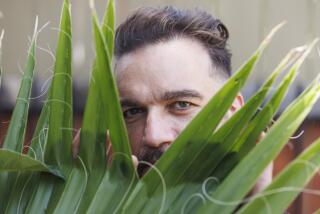Chaparral, showbiz at Malibu Creek State Park
With stunning canyon vistas, spectacular rock outcroppings and mountains as jagged as a crocodile’s tail, Malibu Creek State Park is a delightfully wild place to pitch a tent and investigate on foot -- and it’s only 25 miles west of downtown Los Angeles and just six miles from busy Pacific Coast Highway.
The 6,000-acre park in Calabasas is a particularly good place to hike and mountain bike, with miles of trails and dirt roads that wind to numerous year-round ponds and streams and to a lake flanked by waving cattails and chaparral-covered slopes.
An excellent introductory hike begins at the edge of the campground and snakes 3.5 miles to the lake and back. Just follow the Shady Trail signs down a dirt fire road, past a creek and up a valley till you reach a visitor center (open noon to 4 p.m. weekends).
From the visitor center, take the George Trail upstream to where it rounds sky-scraping walls of volcanic rock. At the site is a lovely rock pool and beyond that is Century Lake. If the setting seems familiar, it might be because it was used as a film location for Tarzan movies and “The New Swiss Family Robinson.” Parts of “Planet of the Apes” was filmed nearby.
Malibu Creek State Park is also one of the last tangible places on Earth to reconnect with Margaret “Hot Lips” Houlihan, Dr. Benjamin “Hawkeye” Pierce, “Trapper John” McIntyre and other characters of “MASH,” the dark-comedy weekly TV series that spanned 11 seasons and followed a team of surgeons and support staff during the Korean War.
The show was filmed on land that had been the property of 20th Century Fox Studios before the state purchased it in 1974.
Parts of the set can be viewed after hiking 2.3 miles on a mostly flat dirt road that starts at the day-use parking lot, hugs a creek bed and wanders through picturesque thickets of valley oaks and grasslands flush with birds -- habitat that has changed little since the Chumash settled here thousands of years ago.
All that remains of the set are the rusty hulks of a Dodge WC-54 ambulance and a Willys Jeep, and above them a flat dirt landing pad where choppers carrying the “wounded” landed.
Except for helping boomers take a stroll down memory lane, the site is seldom used today. Law enforcement occasionally puts a chopper down on the site.
The campground is in a serene valley and contains 62 tent campsites, two wheelchair-friendly bathrooms with flush toilets and solar-heated showers, and four RV campsites. Most of the sites are in the sun, which is fine at this time of year but can be uncomfortable in summer. The campground is best visited during fall, winter and spring.
The top campsites, for privacy and shade, are 27 and 24, followed closely by 7, 17, 21, 22 and 39; all offer the option of pitching a tent under a majestic oak. Every campsite contains a fire pit and picnic table but no hookups.
Campers, be sure to rise early. If you do, you’ll very likely see deer nibbling on grass in the fields near the campground. They are used to seeing bipeds, so it’s easy to get within 100 feet of them to take a picture or just to watch them dine.
Comments? Email feedback@latimes.com
More to Read
Sign up for The Wild
We’ll help you find the best places to hike, bike and run, as well as the perfect silent spots for meditation and yoga.
You may occasionally receive promotional content from the Los Angeles Times.






